Antibody data
- Antibody Data
- Antigen structure
- References [1]
- Comments [0]
- Validations
- Immunocytochemistry [5]
- Immunohistochemistry [4]
- Flow cytometry [2]
- Other assay [1]
Submit
Validation data
Reference
Comment
Report error
- Product number
- MA5-32821 - Provider product page

- Provider
- Invitrogen Antibodies
- Product name
- USP14 Recombinant Rabbit Monoclonal Antibody (JU30-49)
- Antibody type
- Monoclonal
- Antigen
- Recombinant full-length protein
- Description
- Recombinant rabbit monoclonal antibodies are produced using in vitro expression systems. The expression systems are developed by cloning in the specific antibody DNA sequences from immunoreactive rabbits. Then, individual clones are screened to select the best candidates for production. The advantages of using recombinant rabbit monoclonal antibodies include: better specificity and sensitivity, lot-to-lot consistency, animal origin-free formulations, and broader immunoreactivity to diverse targets due to larger rabbit immune repertoire.
- Reactivity
- Human, Zebrafish
- Host
- Rabbit
- Isotype
- IgG
- Antibody clone number
- JU30-49
- Vial size
- 100 μL
- Concentration
- 1 mg/mL
- Storage
- Store at 4°C short term. For long term storage, store at -20°C, avoiding freeze/thaw cycles.
Submitted references PR-619, a General Inhibitor of Deubiquitylating Enzymes, Diminishes Cisplatin Resistance in Urothelial Carcinoma Cells through the Suppression of c-Myc: An In Vitro and In Vivo Study.
Hsu FS, Lin WC, Kuo KL, Chiu YL, Hsu CH, Liao SM, Dong JR, Liu SH, Chang SC, Yang SP, Chen YT, Chang RJ, Huang KH
International journal of molecular sciences 2021 Oct 28;22(21)
International journal of molecular sciences 2021 Oct 28;22(21)
No comments: Submit comment
Supportive validation
- Submitted by
- Invitrogen Antibodies (provider)
- Main image
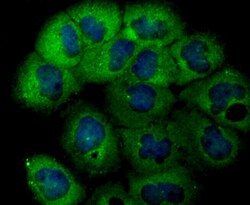
- Experimental details
- Immunocytochemical analysis of USP14 in A431 cells using a USP14 Monoclonal antibody (Product # MA5-32821) as seen in green. The nuclear counter stain is DAPI (blue). Cells were fixed in paraformaldehyde, permeabilised with 0.25% Triton X100/PBS.
- Submitted by
- Invitrogen Antibodies (provider)
- Main image
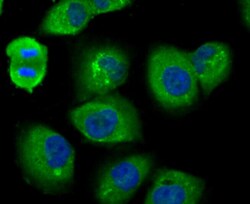
- Experimental details
- Immunocytochemical analysis of USP14 in HUVEC cells using a USP14 Monoclonal antibody (Product # MA5-32821) as seen in green. The nuclear counter stain is DAPI (blue). Cells were fixed in paraformaldehyde, permeabilised with 0.25% Triton X100/PBS.
- Submitted by
- Invitrogen Antibodies (provider)
- Main image
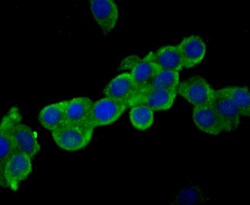
- Experimental details
- Immunocytochemical analysis of USP14 in LOVO cells using a USP14 Monoclonal antibody (Product # MA5-32821) as seen in green. The nuclear counter stain is DAPI (blue). Cells were fixed in paraformaldehyde, permeabilised with 0.25% Triton X100/PBS.
- Submitted by
- Invitrogen Antibodies (provider)
- Main image
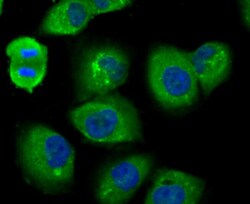
- Experimental details
- Immunocytochemical analysis of USP14 in HUVEC cells using a USP14 Monoclonal antibody (Product # MA5-32821) as seen in green. The nuclear counter stain is DAPI (blue). Cells were fixed in paraformaldehyde, permeabilised with 0.25% Triton X100/PBS.
- Submitted by
- Invitrogen Antibodies (provider)
- Main image
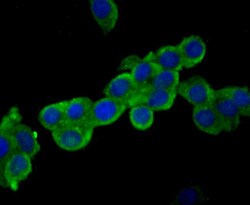
- Experimental details
- Immunocytochemical analysis of USP14 in LOVO cells using a USP14 Monoclonal antibody (Product # MA5-32821) as seen in green. The nuclear counter stain is DAPI (blue). Cells were fixed in paraformaldehyde, permeabilised with 0.25% Triton X100/PBS.
Supportive validation
- Submitted by
- Invitrogen Antibodies (provider)
- Main image
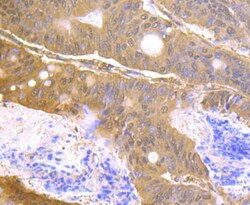
- Experimental details
- Immunohistochemical analysis of USP14 of paraffin-embedded Human colon cancer tissue using a USP14 Monoclonal antibody (Product #MA5-32821). Counter stained with hematoxylin.
- Submitted by
- Invitrogen Antibodies (provider)
- Main image
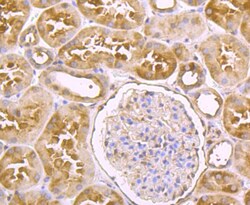
- Experimental details
- Immunohistochemical analysis of USP14 of paraffin-embedded Human kidney tissue using a USP14 Monoclonal antibody (Product #MA5-32821). Counter stained with hematoxylin.
- Submitted by
- Invitrogen Antibodies (provider)
- Main image
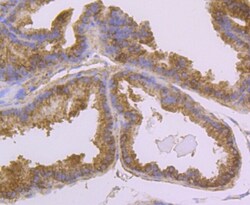
- Experimental details
- Immunohistochemical analysis of USP14 of paraffin-embedded Mouse prostate tissue using a USP14 Monoclonal antibody (Product #MA5-32821). Counter stained with hematoxylin.
- Submitted by
- Invitrogen Antibodies (provider)
- Main image
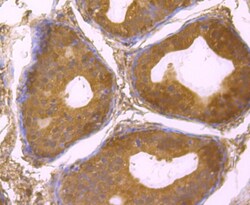
- Experimental details
- Immunohistochemical analysis of USP14 of paraffin-embedded rat epididymis tissue using a USP14 Monoclonal antibody (Product #MA5-32821). Counter stained with hematoxylin.
Supportive validation
- Submitted by
- Invitrogen Antibodies (provider)
- Main image
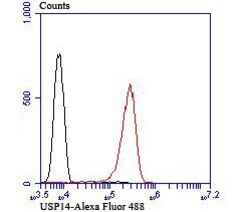
- Experimental details
- Flow Cytometric analysis of USP14 in Jurkat cells using a USP14 Monoclonal Antibody (Product # MA5-32821) at a dilution of 1:100, as seen in red compared with an unlabelled control (cells without incubation with primary antibody; black). Alexa Fluor 488-conjugated goat anti rabbit IgG was used as the secondary antibody.
- Submitted by
- Invitrogen Antibodies (provider)
- Main image
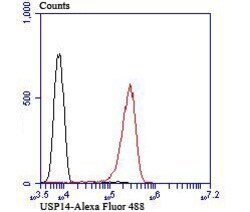
- Experimental details
- Flow Cytometric analysis of USP14 in Jurkat cells using a USP14 Monoclonal Antibody (Product # MA5-32821) at a dilution of 1:100, as seen in red compared with an unlabelled control (cells without incubation with primary antibody; black). Alexa Fluor 488-conjugated goat anti rabbit IgG was used as the secondary antibody.
Supportive validation
- Submitted by
- Invitrogen Antibodies (provider)
- Main image
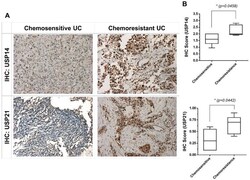
- Experimental details
- Figure 2 Immunohistochemical staining of USP14 and USP21 in tumor tissues obtained from patients with chemosensitive and chemoresistant metastatic bladder urothelial carcinoma. ( A ) Five chemoresistant and five chemosensitive clinical tumor samples were IHC-stained with USP14 and USP21 antibodies. The tissue sections were photographed at 200x magnification. ( B ) The IHC scores of USP14 and USP21 expression from chemoresistant and chemosensitive tumors. Data were analyzed using the unpaired two-tailed Student's t -test and are presented as means +- standard deviation; * p < 0.05 represents a significant difference between the indicated groups.
 Explore
Explore Validate
Validate Learn
Learn Western blot
Western blot Immunocytochemistry
Immunocytochemistry